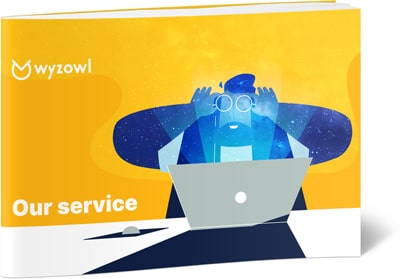Did you know that how you onboard your employees can actually impact your retention rate?
It seems strange to think about the day your employees will move on when you’ve only just hired them, but we all know how important first impressions can be.
According to a report by Glassdoor, organisations with a strong onboarding process can improve the retention of new hires by 82%.
That’s a pretty impressive figure! And it’s worth taking note of, considering the average employer spends £3,000 and 27.5 days hiring a new worker.
Video can be a very effective tool for employee training. Videos are engaging. They’re fun. Memorable. Not to mention, cost-effective.
In this article we’re going to take a look at how you can create brilliant employee training videos that work!
1. Tell a story
In his world-renowned book, Sapiens: A Brief History of Humankind, Yuval Noah Harari does an excellent job of explaining just how important stories are to us as a species. He states:
“Homo sapiens is a storytelling animal that thinks in stories rather than in numbers or graphs, and believes that the universe itself works like a story, replete with heroes and villains, conflicts and resolutions, climaxes and happy endings.”
It makes sense then for stories to be a great device to use if you want your training sessions to be more memorable.
A training video that grips your new employees with an engaging story is bound to linger on in their memory – and have a more lasting impact – than a written handbook detailing roles and responsibilities.
Here’s an example of an employee training video we made for Nikwax:
This video showcases different workplace scenarios that new employees will come across – such as a customer coming into the store for a waterproof jacket or how to effectively sell the aftercare product – and uses the power of animation and a good story to make the message stick.
Of course, the great thing about video is that the message doesn’t have to stick. You can give your new employees access to your training videos and encourage them to watch the training materials as many times as they need to – even pausing to make notes.
2. Let your team do the talking
Getting your team involved in your employee training videos is a great way to introduce new staff members to your company culture while also introducing some friendly faces.
Here’s an example from Netflix:
Videos like this can be particularly useful if you have a huge company and new hires won’t get the chance to meet everyone right away.
In addition to having a more personal feel, using your team in your training videos can also save you a lot of money.
You don’t need to hire actors or a film crew, you can simply put a chair in an empty conference room, point a camera at it, sit one of your employees down and you’re ready to rock!
Here’s another example from Virgin Media. The audio quality isn’t great as the video is very ‘home-made’ and was shot out in the field, but it’s still an interesting and genuine way to introduce new team members to the company:
If you’re concerned about employee turnover potentially rendering your employee-focused training videos out of date, you could consider using animation.
Using animated characters to represent your team is a great way to make your videos personal, but not so personal that you need to replace them every time someone leaves.
It can also be fun for your team to see themselves as animated characters! Dropbox did something very similar with puppets. Check it out:
3. Make it relatable
It doesn’t matter how long you’ve been in your current role, we all know what it feels like to start a new job. You’re nervous. Excited. Exhausted from trying to take in every new piece of information.
One way to put new employees at ease is to use a relatable tone of voice in your training videos and represent issues that they can also relate to.
Here’s an example from Reach Out:
This video covers the difficult and sensitive topic of workplace bullying. While being an uncomfortable issue to talk about, it’s also a very important and necessary to discuss this with new employees.
Everyone at your workplace needs to know what will and will not be tolerated. They need to feel safe. And they need to know who to talk to if they’re struggling.
The video above does an amazing job of tackling the topic at hand by covering relatable situations in a conversational tone-of-voice.
Animation is an effective medium for tackling sensitive topics like this because it helps to destigmatize the situation at hand, and also doesn’t target any one group of people.
4. Don’t be afraid to have fun!
Take a look at this training video from Tesco:
At first, it just looks like one of the same-old boring training videos we’ve all seen before – generic scenarios, elevator music, and a painfully slow pace.
But around the 45 second mark, the video transforms into something a lot more fun! The music becomes upbeat, we’re treated to some fast-paced editing and even the addition of some comic-book style animation.
This video is interesting in that the first few scenes give us a glimpse into what it could have been. This could have been a boring and straight-forward story about how to deal with spillages – but Tesco decided to have some fun!
After all, cleaning up spillages is hardly rocket-science. And if it was treated as such – broken down in a boring step-by-step manner, it could make new employees feel patronised.
Remember, when it comes to training videos, your new employees are also your viewers – you don’t have to spell everything out for them in a literal way. You can tell a story, and, importantly, you can have some fun!
5. Make it bite size
When using videos to train new employees, you could run the risk of making the whole thing a passive experience.
If all you do is hit play and then leave the employee to watch the videos – how do you know they’re actually learning what you need them to?
Shorter, bite sized videos – with time for question and answer sessions in between – can help to combat this issue.
Here’s an example from Canity:
And here is another one, covering a different topic:
These short videos each tackle a different issue in a humorous and easy-to-digest manner.
You’ll be asking new employees to take in a lot of brand new information, so breaking it down like this will leave space for them to ask questions and also digest what they’ve just watched, and potentially make some notes.
According to our State of Video Marketing 2021 survey, most people would prefer to learn about a new product or service by watching a short video – the keyword here being short!
6. Play with interactivity
Video is always evolving, and one of the latest evolutions is interactive video.
Interactive videos are great for employee training because they put the viewer in the driver’s seat. You can create interactive quizzes – where you show new employees a clip and then ask them questions about it.
And you can also create tailored paths – so you can use the same video to train different people, depending on what they need to know.
Here’s a great example from McDonalds:

This youthful and fun video engages viewers and makes the learning experience more, well…interactive!
According to WIREWAX, interactivity increases time spent in video by 47%. And interactive videos are around 32% more memorable than traditional video.
Adding interactive elements to your videos also means you can get access to reports that show you exactly how users interacted with the video – so you can see just how effective your training has been!
7. Ensure uniformity
One of the biggest advantages that training videos have over traditional classroom training sessions is that you can ensure everyone has the same experience.
This benefit was particularly important to pharmaceutical company, AstraZeneca. With almost 70,000 employees, they needed to ensure uniformity across their employee training.

To do this, they used Facebook’s Workplace platform to communicate company strategy through live videos.
They have used this same content to train staff from when they started the business, with just 100 employees, to the present day, with almost 70,000.
This training method resulted in a 35% increase in content consumption from the team, compared to when they used an intranet.
When you create and roll out employee training videos, you’re not only ensuring uniformity, you’re also creating a resource that employees can rewatch any time they need a refresher.
Final thoughts
LinkedIn’s 2020 Workplace Learning Report discovered that increasing learner engagement is among the top 3 priorities of learning and development teams.
And video is one of the best ways to do that. Videos are fun, memorable, and can be used time and time again, to ensure consistency when training new employees.
For more information check out our employee training video production page.






